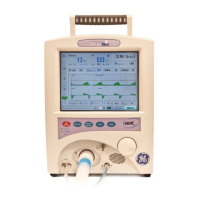Appendix D: Theory of Breath Delivery
215
Pressure control breath - mandatory breath in which the ventilator provides
constant pressure at a preset level during inspiration.
Patient Breath. Any breath in which the patient initiates and terminates the
inspiration phase. This breath type is divided into two secondary types
according to the method by which the inspiratory phase is controlled:
o Spontaneous breath - the ventilator helps the patient to breathe by
maintaining the inspiratory pressure at the baseline level (PEEP).
o Pressure Support breath - the ventilator elevates the inspiratory
pressure to the preset support pressure level above the baseline and
maintains this pressure during the inspiration phase.
ADAPTIVE FLOW AND ADAPTIVE I-TIME
Unique to the iVent
TM
201, Adaptive Flow
TM
and Adaptive I-Time™ are patient
responsive controls to establish appropriate peak flow and inspiratory time
during volume control breath delivery. The main goal of the algorithm is to match
the patient demand for flow during inhalation while reducing airflow hunger and
increasing patient comfort.
Should the Adaptive Flow algorithm determine that the peak flows achieved by
the patient’s spontaneous breathing exceed the peak flows that are determined
necessary to achieve the set tidal volume, then the algorithm matches the
patient’s peak flow so as to avoid the feeling of “air hunger” in the patient. In this
situation, the ventilator does not realize an I:E ratio of 1:2.
In the absence of sufficient spontaneous patient efforts, Adaptive Flow and
Adaptive I-Time work together in volume control modes (SIMV and A/C). When
used together (The default state for SIMV Volume Control mode) these two
features seek to achieve an I:E ratio of 1:2 (As close as possible within clinical
limitations, such as Pressure Limit and Alarm Pressure Cutoff settings as well as
minimum and maximum Inspiratory Time allowed).
Changes in the overall breath rate are tracked and the Adaptive I-Time algorithm
adjusts the inspiratory time over approximately 10 breaths in order to maintain
the I:E ratio at 1:2. The Adaptive Flow algorithm accommodates changes in the i-
time and automatically adjusts the peak flow so that the delivery of the set tidal
volume for the i-time determined by the Adaptive I-Time algorithm is assured.
The Adaptive I-time changes inspiratory time as required to achieve a 1:2 I:E
ratio.
If respiratory rate increases, the inspiratory time decreases and the
mandatory peak inspiratory flow increases to deliver the set tidal volume.
If respiratory rate decreases, the inspiratory time increases and the
mandatory peak inspiratory flow decreases to deliver the set tidal volume.
If flow is insufficient to deliver the tidal volume, inspiratory time gradually
increases in an attempt to deliver the set tidal volume. In this situation the
ventilator does also not achieve I:E ratios of 1:2. For this reason, the user is
advised to leave the inverse I:E ratio alarm "ON" when using Adaptive Flow and
adaptive I-Time. If inverse I:E ratios are achieved, it is recommended that the
ventilator controls are set manually.

